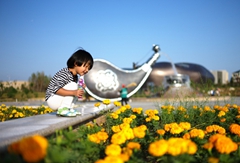Manhan folk song (Manhandiao)
Updated: 2018-05-08  Print
Print 



Manhandiao came into being about 200 years ago.
In the late Qing Dynasty (1636-1912), Han Chinese from Shanxi and Shaanxi swarmed into Zhunger Banner, Ordos. The Han and Mongolian people that lived together facilitated closer exchanges in not only life and production but in culture, and more importantly, in folk music.
In terms of melody, Manhandiao is primarily based on the short Mongolian song of Erdos, at the same time taking merits from the Mountain-climbing Song and the Song-and-dance Duet originating from Shanxi and Shaanxi.
In terms of lyrics, it falls into seven different types - recalling past sufferings, extolling, romance, eagerness, sadness, pain of parting and aspirations.
Its principal feature is that one song can be sung in several different tunes, while several songs might have the same exact tune.
Manhan songs belong to the genre of ditty and are performed accompanied by a three-musical-instrument band.
Compared with mountain songs, Manhandiao has absorbed more elements of art, while displaying a more fluent melody and stronger expression.
Manhandiao came out of ordinary people and simply mundane life. It has played an important role in advocating and enriching culture, in Zhunger's politics, economics, production and life in every period.
Today, it has spread rapidly outside of Zhunger to the western Inner Mongolia and the neighboring Shanxi and Shaanxi region and has occupied a place in China's ethnic folk music history.





 Ordos Impression
Ordos Impression Ordos WeChat
Ordos WeChat Ordos Reported
Ordos Reported


